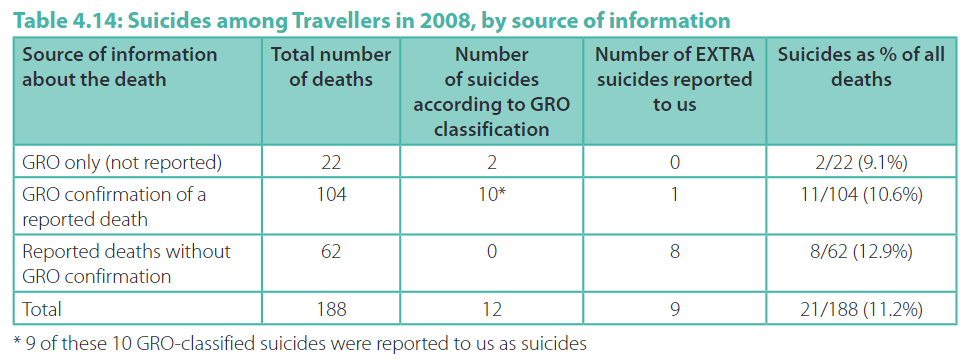- The All Ireland Traveller Health Study (AITHS), published in 2010 and based on deaths that took place in 2008, found that 11.2% of Traveller deaths that year were a result of suicide.
- Research from AITHS indicated that the suicide rate amongst Traveller males was 6.6 times larger than with the general male population – but this calculation purposely left out some data and the report acknowledge this could be an underestimate. Variations in the data for women were not deemed statistically significant.
- Although the AITHS is an ageing piece of research, there is no other data that is more recent or more comprehensive on this matter, and this remains the best-available evidence on this issue.
On 5 December during a debate in the Dail, Sinn Féin TD Mark Ward said:
“Some 11% of all Travellers will die by suicide. This is shocking. It is over seven times more than the general population. While we can all get lost in statistics, each one of these is a man, a woman or a child with hopes, dreams and ambitions.”
Mr Ward’s claim that around 11% of Travellers die by suicide is supported by data in the All Ireland Traveller Health Study (AITHS) from 2010, a significant piece of work examining the health and wellbeing concerns of Travellers on the island of Ireland.
His other claim – that this suicide rate is over seven times higher than among the general population – deviates slightly from data in the AITHS, which suggests such deaths are around 6.6 times more frequent among males in the Travelling community then with men in the general population. However, this calculation is based on some specific uses of the gathered data (outlined below) and the report states that its own calculation could be an underestimate.
The calculated suicide rate for Traveller women was almost five times higher than among women in the general population – but this was not deemed statistically significant.
This does not confirm Mr Ward’s assertion about the Traveller suicide rate being over seven times higher than the general population, but it doesn’t contradict it either.
Although it uses old data, the AITHS remains the central piece of research into Traveller health and, in particular, suicide rates among the Traveller community across the island of Ireland. Its figures are still cited by government departments and other organisations, as well as Mr Ward himself, who directed us to this report when we asked him about this claim.
So, while there are significant caveats around these figures, the research in the AITHS remains the best-available data on this matter.
- Figures
Back in 2010, the All Ireland Traveller Health Study (AITHS) was published.
Described as “the first study of Traveller health status and health needs that involves all Travellers living on the island of Ireland, North and South”, a summary of its findings is here.
The research involved a specific look at relevant health demography and vital statistics, including the following information:

Figure 1 – source: AITHS 2010 Demography and Vital Statistics
Note that “GRO” refers to the General Register Office, which collates, registers and publishes information about deaths in Ireland, whereas “reported deaths” means information that researchers gathered directly from the Traveller community.
The main findings from this data include that 21 out of 188 Traveller deaths in 2008 were the result of suicide – a rate of 11.2%, backing up the original claim.
This figure relies on both official data from the GRO as well as direct engagement between researchers and the Traveller community. Note that the overall suicide rate only among deaths that have been reported by the GRO is marginally lower.
In terms of how this compares to the general population, the report includes the following table:

Figure 2 – source: AITHS 2010 Demography and Vital Statistics
The report states: “The suicide rate in male Travellers is a statistically significant 6.6 times higher than in the general population. The female suicide rate is also higher but not at a statistically significant level.”
Mr Ward said suicides among the Traveller community are “over seven times more than the general population”. The findings from AITHS appear to be at odds with this – but that’s not the whole story.
In making the comparison seen in Figure 2, the researchers opted only to use figures that came from the GRO and avoided data that only came from direct reporting from the population. The paper states:
“[Our] decision, to base results on the GRO-confirmed deaths only, may have resulted in an underestimate of the proportion of suicides in the Traveller population. Thus the true rate of suicide among Travellers could be higher than the figure given here.”
So, while Mr Ward’s assertion is slightly above that calculated in the report, the report itself explicitly acknowledges that it could be underestimating this figure.
- Old data
There are significant caveats here.
Traveller engagement with statutory services and records can be inconsistent, when compared with the general population. This is something discussed with the AITHS itself, which goes to some lengths to discuss the efforts that were made to produce and publish the information contained within that report.
Furthermore, this dataset is old, it relates only to one year (2008), and the sample sizes are quite low (21 deaths by suicide out of 188 deaths total).
Despite all this, the AITHS remains the best source of data about Traveller suicide. No equivalent study has taken place since and regular national statistics simply do not cover this area in the same detail.
- Other sources
The AITHS is almost 15 years and its data about suicide, which comes from 2008, is even older than that.
However, FactCheckNI was unable to identify data that is either more comprehensive or more recent. This followed both a dedicated search on our own part, as well as requests sent to various agencies and other organisations detailed below. If you are reading this and aware of more up to date data – please let us know here.
NI’s Department of Health told us that “Irish travellers are a vulnerable community and often encounter a range of negative impacts which can have adverse effects on mental health including bias, racism and discrimination when seeking work” and pointed out that the Public Health Agency recently provided funding for a Traveller Health and Wellbeing Project Support post in the Western HSC Trust Area.
The department also pointed us to a 2021 Irish parliamentary committee report which includes figures about suicides in the Traveller community – figures that are ultimately sourced from the AITHS in 2010.
According to NI’s Department of Finance, which currently handles media enquiries for the Northern Ireland Statistics and Research Agency (NISRA), told us that:
“The ethnic background of individuals is not collected as part of the death registration process, therefore NISRA would not hold this information.”
Ireland’s Department of Health told us:
“The numbers of deaths by suicide, by ethnicity, or within the Traveller Community, are not provided by the CSO. We know from studies, such as the All-Ireland Traveller Health Study that suicide rates are higher among the Traveller Community than in the settled community.”
Ireland’s Central Statistics Office (CSO) told FactCheckNI that its death statistics rely on figures from the GRO and within that data “there is no information related to the ethnicity of the individual(s) who have died therefore we are unable to produce any classifications relating to ethnicity.”
Pavee Point, an organisation dedicated to improving the lives of the Traveller and Roma communities, highlighted research from last September looking at Traveller suicides – which again relies on data collected from 2010’s AITHS.
If you or someone you know is experiencing suicidal thoughts or is in crisis, immediate help is available.
In Northern Ireland, call:
The Samaritans – 116 123
Lifeline – 0808 808 8000
In RoI, call:
Samaritans Ireland – 116 123 Pieta – 1800 247 247




